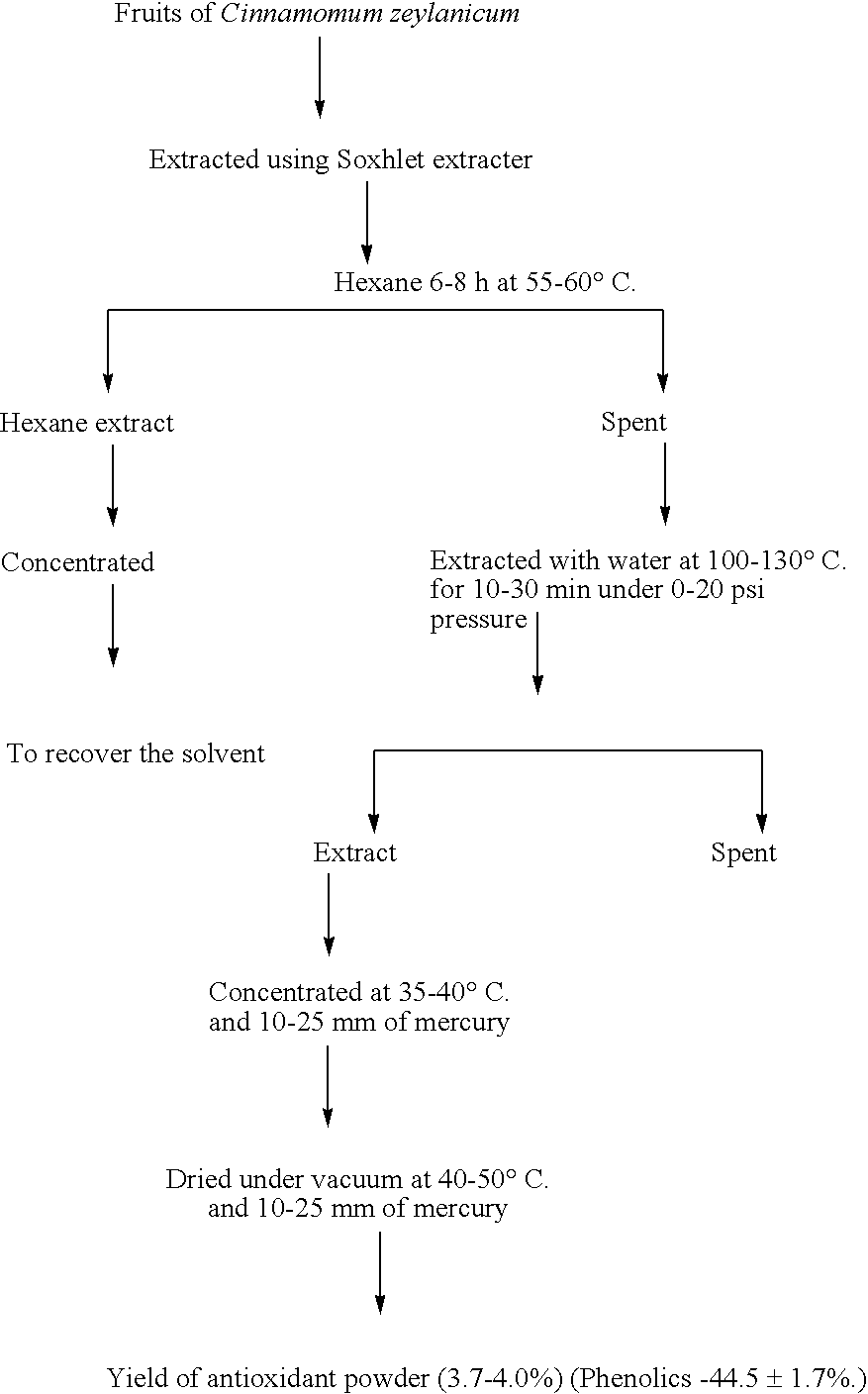Use of fraction from Cinnamomum zeylanicum for preserving food
a technology of cinnamomum zeylanicum and cinnamomum zeylanicum, which is applied in the directions of plant/algae/fungi/lichens, animal repellents, biocide, etc., can solve the problems of mild odor, spicy taste, and affecting the taste of leaf oil
- Summary
- Abstract
- Description
- Claims
- Application Information
AI Technical Summary
Benefits of technology
Problems solved by technology
Method used
Image
Examples
example 1
[0059]50 g of fruits of Cinnamomum zeylanicum were powdered using mixer grinder to get a mesh size of 60-80. The powder was extracted using 200 ml of hexane at 60° C. for 6 h in a Soxhlet extractor. The hexane extract was concentrated to recover the solvent. The spent was further extracted with 250 ml water at 120° C. under 15 psi pressure for 20 min. The water extract was filtered using Whatman filter paper No.1. The extract was concentrated at a temperature of 40° C. and under reduced pressure at 25 mm of mercury and dried in vacuum oven at 40° C. and 10 mm of mercury to get 1.85 g of brown powder.
example 2
[0060]Fruits (100 g) of Cinnamomum zeylanicum were powdered and to get a mesh size of 80 and it was extracted with 400 ml of hexane by using Soxhlet extractor at 55° C. for 8 h. The extract was collected and concentrated to recover the solvent. The spent obtained after hexane extraction was further extracted with 600 ml water at 130° C. under 20 psi pressure for 10 min. The extract was filtered through Whatman filter paper no. 1. The filtrate was concentrated at a temperature of 35° C. and under a reduced pressure at 25 mm of mercury and dried in vacuum oven at a temperature of 50° C. and under vacuum of 25 mm of mercury. The yield of brown powder was 4.03 g.
[0061]The water extract obtained in the above methods was screened for antioxidant activity using 1,1-diphenyl-2-picrylhydrazyl (DPPH) [J. Agricultural and Food Chemistry, 50, 81-86, 2002]. It showed 76 and 94% antioxidant activity at 25 and 50 ppm respectively using DPPH method, while BHA showed 71 and 94% and 25 and 50 ppm res...
example 3
[0062]Fruits (150 g) of Cinnamomum zeylanicum were powdered to get 80 mesh size and it was extracted with 600 ml of hexane by using Soxhlet extractor at 60° C. for 6 h. The extract was collected and concentrated to recover the solvent. The spent obtained after hexane extraction was further extracted with 750 ml water at 100° C. for 30 h. The extract was filtered through Whatman filter paper no. 1. The filtrate was concentrated at a temperature of 40° C. and under reduced pressure at 10 mm of mercury and dried in a vacuum oven at 40° C. under vacuum at 25 mm of mercury to get 5.9 g of brown powder.
[0063]The water extract obtained, was screened for antioxidant activity using β-carotene-linoleate model systems. The water extract showed 78 and 83% antioxidant activity at 100 and 200 ppm respectively, using β-carotene-linoleate method, while BHA showed 81 and 89% antioxidant activity at 100 and 200 ppm.
[0064]The linolenic acid present in some of the edible oils, hence the same study can ...
PUM
 Login to View More
Login to View More Abstract
Description
Claims
Application Information
 Login to View More
Login to View More - R&D
- Intellectual Property
- Life Sciences
- Materials
- Tech Scout
- Unparalleled Data Quality
- Higher Quality Content
- 60% Fewer Hallucinations
Browse by: Latest US Patents, China's latest patents, Technical Efficacy Thesaurus, Application Domain, Technology Topic, Popular Technical Reports.
© 2025 PatSnap. All rights reserved.Legal|Privacy policy|Modern Slavery Act Transparency Statement|Sitemap|About US| Contact US: help@patsnap.com

